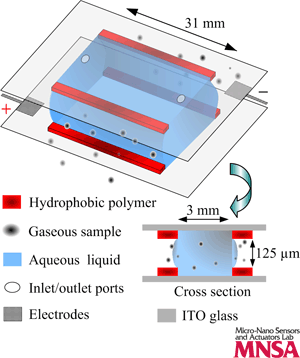We present a relatively simple and effective method for acquiring gaseous samples into microfluidic channels. Hydrophobic polymers are photopatterned on hydrophilic substrates. Due to surface tension, aqueous liquid is confined by the hydrophobic polymers, but not completely blocked by a physical wall, thus allowing an interface for gas-liquid interaction. Here, the mechanism is demonstrated by using hydrophobic (poly)iso-bornyl acrylate polymer patterns on hydrophilic glass substrates, and through a Nessler's reagent-ammonia reaction that exhibits changes in color and electrical resistance.
